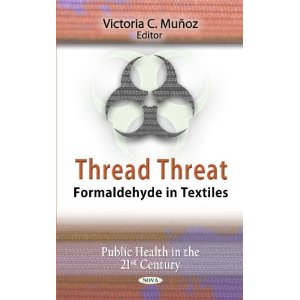I am planning on buying either Retayne or Raycafix, but am concerned about the carcinogenic content (formaldehyde)? How dangerous are these?
Name: Matt
by Monona Rossol

Thread Threat: Formaldehyde in Textiles
edited by Victoria C. Munoz
Formaldehyde, one of the most widely produced chemicals in the world, is used in many products, including disinfectants, pressed wood and clothing and other textiles. Exposure to this chemical, which has been linked to adverse health effects for more than 30 years, typically occurs through inhalation and dermal contact. Formaldehyde can be used to enhance wrinkle resistance in some clothing and textiles, especially those made of cotton.
Country or region: US
Message: Hi, I have just read your article on dye fixatives. Thanks for posting, very informative. I had been told that vinegar worked and before I bought it wanted to check and see if it did, and sure enough it apparently does not! I am planning on buying either Retayne or Raycafix, but am concerned about the carcinogenic content (formaldehyde)? How dangerous are these? It is not worth any amount of risk to me really just to make my jeans darker, but if it's almost nonexistent I would love to try these. Do the dangerous chemicals stay on the jeans after application? Also, it says Raycafix is stronger, is it possible it contains more carcinogens? I would really appreciate any information you can give me. Thanks so much!
I'm afraid I must point out to you that this is a risk you are already taking and have taken for many years. Nearly all cotton clothing that you can buy in the US contains formaldehyde finishes. This is never declared on the label. A garment may be made of 100% cotton and yet be finished with formaldehyde-containing finishes, to give it desirable properties such as resistance to wrinkling. The only exception is clothing whose manufacturer makes specific claims about being free of the usual finishes, or specifically claiming to be free of formaldehyde. This is one of the reasons why you should never wear clothing after purchasing without first washing it at least once, in order to remove the worst of the irritating or even possibly carcinogenic finishes.
(If you are concerned about exposure to formaldehyde, you will also wish to be careful about furniture; furniture made of pressed wood, such as inexpensive furniture from Walmart or Ikea, frequently contains such large quantities of formaldehyde in the glue, holding the strands of wood together into the shapes of boards, that outgassing of formaldehyde from new furniture can reach significantly unhealthy levels in your home.)
The amount of formaldehyde contained in Retayne and other brands of dye fixative is small, though admittedly the very idea of it is disturbing. By law, in the US, the Materials Safety Data Sheets (MSDS) must contain the names of all ingredients which are health hazards that are present at a concentration of 1% or greater, and they must list all carcinogens even if they are present at only 0.1% or greater. An MSDS for undiluted Clariant Cassofix FRN300 (sold as Dharma Dye Fixative) indicates that it contains 2% methanol and 0.5% formaldehyde. This is before the dilution that takes place before a retailer such as Dharma Trading Company sells it to us, so the actual levels as purchased are lower, probably about 0.5% or less methanol and 0.15% formaldehyde. The MSDSs for the Retayne and Jacquard brands of dye fixative do not list any methanol or formaldehyde at all, because, as diluted before sale, their levels are below the legal limits.
In use, these products are, of course, diluted considerably more. The instructions for Dharma Dye Fixative say to use one ounce per pound; if you treat a five-pound load of fabric in a twenty-gallon top-loading washing machine, then the final dilution will be five fluid ounces in twenty gallons of water; twenty gallons contain 2,560 fluid ounces, so the dilution is an additional 1:512. The 0.15% formaldehyde in Dharma Dye Fixative would therefore be diluted to 0.0003%. Much of the formaldehyde and methanol will be washed away with the rinse water, while much of the active ingredient of the fixative, a transparent cationic polymer, continues to cling to the negatively charged dye particles to help fix them in place.
My conclusion is that we don't need to worry particularly about the levels of formaldehyde to these dye fixative products, though it's wise to wear gloves while dispensing them and to use no more than the recommended quantities. I do take care to avoid purchasing furniture made from particle board.
As far as your jeans go, I must warn you that these fixatives might not work! Cationic dye fixatives are not intended for use on neutrally-charged dyes such as indigo. Indigo is used to color most blue denim jeans. Cationic dye fixatives work very well on the cheap direct dye that is used to color a large proportion of commercial natural-fiber clothing. They don't work when the problem is dye that rubs off of a garment when it is still dry, only on the problem of dye that runs when it gets wet, especially in the laundry. With blue jeans, the issue commonly is that the dye is purposefully applied incorrectly, so that the color will wear quickly, making your blue jeans appear worn before much use; this is particularly popular for jeans that are sold prewashed, or that are preworn in some other way.
Unlike Retayne, Raycafix and Dharma dye fixative are claimed to help keep indigo dark longer; I am not sure how well it does so, since that is outside the normal function of this sort of dye fixative. However, the Dharma folks do say in their catalog, "Does a good job with fabric that's been dyed with indigo!!", suggesting that they've tested it, so it's worth a try.
If you want to make your jeans darker than they are now, you can dye them in the washing machine with long-lasting Procion MX fiber reactive dyes, which will need no Retayne or other cationic dye fixative if you follow the standard instructions, using soda ash or washing soda as the dye fixative and salt to help get the best yield from the dye. Dye will color both the light threads and the dark threads in the denim weave, resulting in a much more solid color. This effect may or may not be desirable to you. It is an absolutely formaldehyde-free process, however.
(Please help support this web site. Thank you.)
(Please help support this web site. Thank you.)
Posted: Sunday - December 18, 2011 at 10:37 AM
Follow this blog on twitter here.
Quick Links
- All About Dyes & Dyeing Top -
- Top of this blog -
- FAQ -
- The Dye Forum -
- How to Tie Dye - How to Batik -
- Books - Toys - Plants -
- Top of this blog -
- FAQ -
- The Dye Forum -
- How to Tie Dye - How to Batik -
- Books - Toys - Plants -
More in this category:
- -
Statistics
Total entries in this blog:
Total entries in this category:
Published On: Aug 29, 2012 02:49 PM
Total entries in this category:
Published On: Aug 29, 2012 02:49 PM
